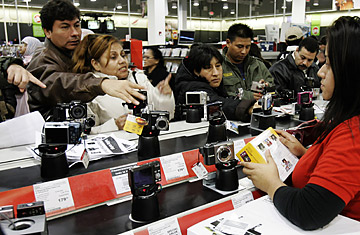
Shoppers look at digital cameras on display at a Circuit City electronics store in North Bergen, N.J.
Let's say you're doing some last-minute Christmas shopping. A purely theoretical situation, we're sure. You walk into a Best Buy to check out digital cameras. One model has a higher resolution than another, but you can't tell the difference in picture quality. The higher res camera costs an extra $120 and doesn't come in the color you want. Still, it's the one you buy.
Why? Because product specifications — like pixel count — disproportionately sway our decisions as shoppers, even when our own experiences tell us they don't matter. That holds true for a range of things we buy, from cell phones to potato chips, as demonstrated by a series of studies to be published in the April issue of the Journal of Consumer Research. "Specifications can be very misleading, even if marketers are honest," says Christopher Hsee, a professor of behavioral sciences and marketing at the University of Chicago Booth School of Business, who ran the experiments with researchers at Shanghai Jiao Tong University. "Consumers are sometimes willing to pay a lot more, even when the underlying experience is the same."
In one experiment, the researchers asked people to pick between two models of digital camera. Model A, the subjects were told, took sharper photos, and model B took ones that were more vivid. They were shown examples of photos taken with each camera, and told they'd never print a photo larger than the sample. Twenty-six percent of people chose model A. Yet when another group was told the same thing, and given the additional information that model A was a 4-megapixel camera while model B was a 2-megapixel version, a full 75% chose model A. "People say, I don't trust my own experience, but I trust those numbers," explains Hsee. How information is presented can also have a drastic effect: when resolution was expressed as 2,900 dots on the diagonal as opposed to 4 million over the entire screen, preference for model A fell back to 51%.
It's not just specs printed on a box we need to be cautious of. Our own, self-generated quantifications can unduly influence us as well. In another experiment, subjects were given two towels. Towel A was softer and towel B was better-looking. Not surprisingly, 57% of people said they preferred towel A—a baseline measure of people's inherent preference.
Then in a separate group, subjects were asked to draw circles to represent the softness of each towel — the softer the towel, the larger the circle. After estimating the area of each circle they'd drawn, those people were then given a choice between towels, and 83% picked A, 26 percentage points higher than the control group. By assigning a number to their own experiences, "they changed their decisions," says Hsee. It's not hard to imagine using a product, talking about it on a web site for other consumers, and, in the process, upping your own chances of buying more.
